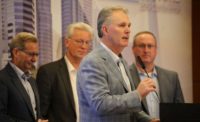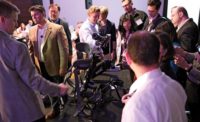
In an experiment to sort out the differences between manufacturers' claims of individual component performance and the real-life delivery of installed photovoltaic collector arrays, one California electrical contractor has built a test facility on top of its headquarters. Mimicking a Silicon Valley-style wine tasting, the goal is to test multiple vendors' solar products.
"We are testing different components in side-by-side analysis, [which] can be compared to computer models," says Saurabh Samdani, the project development engineer at Cupertino Electric Inc., San Jose, Calif., who came up with the models. "The individual components will perform a certain way in a lab, and they'll perform a certain way in their individual cut sheet. But when you assemble them in real life, the results are always different. That's why we're doing it."
The benefit of side-by-side testing is that all the devices are experiencing the same weather conditions, says John Curcio, Cupertino chief commercial officer. His engineers refused to rely entirely on manufacturers' specs when they were advising customers, so they built the lab.
"Most of this data just isn't available," says Curcio. The product lab-test results will be made available only to Cupertino's customers, he says.
Curcio and his team are testing monocrystalline, polycrystalline, thin-film and copper indium gallium selenide solar cells. They're testing three different types of inverters that transfer the electricity to AC from DC for the utility grid. The panels are also rigged to various rack setups. The team is employing several types of irradiance sensors to monitor the systems.
"We're agnostic as far as technologies go," says Curcio, who didn't flag a particular brand of panel or inverter as being the all-around best.
Just monitoring the lab is another part of the research. "We've chosen to build an asset management platform—web-based tech—so we can know weather data, in real time, to prepare and contrast side by side," says Curio.
Bear Creek High School, Stockton, Calif., commissioned a solar array from Cupertino that was installed atop car ports. It is projected to produce over a megawatt of energy a year.
Engineers created a monitoring system for the school's panels that tells the current weather conditions, status of the panels and destination of the energy in real time. The system can be viewed online at cupertino.kiosk-view.com/bear-creek-hs.
The team wouldn't recommend a specific manufacturer. "Most of the name-brand panels perform very well," says Samdani. "What makes the difference is the amount of space a customer has access to." If space isn't a problem, Samdani recommends thin- film or polycrystalline panels because they cost the least in terms of dollars per kilowatt hour. "In certain scenarios, monocrystalline, which is high efficiency, will do better, like when you don't a have a lot of space," says Samdani.






Post a comment to this article
Report Abusive Comment